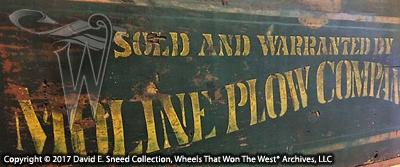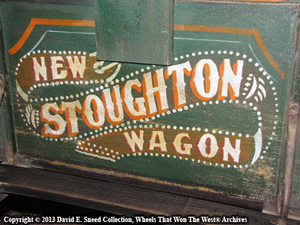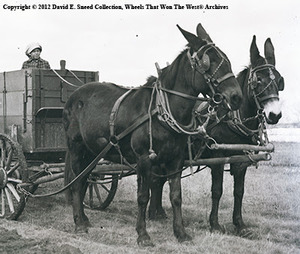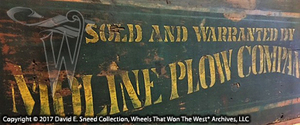From old photos, catalogs, ledgers, andbusiness correspondence to the vehicles, themselves, we’re always looking forrare survivors from America’s first transportation industry. Several years ago, I ran across a near-mint-conditionMoline Mandt wagon and feel fortunate to have been able to add it to ourcollection of wagons and western vehicles. The beginning of the Mandt wagon brand dates back to 1865. Whether you’re talking about earlytransportation, product ingenuity, or the growth of agriculture in the U.S.,this vehicle brand is chock full of history. Not long ago, I came across an article related to Mandt in the August 5,1911 issue of “The Implement Age.” Afterthe company founder, T.G. Mandt passed away in 1902, the company assets wereeventually sold to the Moline Plow Company in Moline, Illinois. That firm immediately capitalized on theMandt legacy by building the Moline Mandt wagon and other similarly constructedbrands. Below are a few segments fromthat August issue of “The Implement Age”...
 |
| As shown on this century-old wagon endgate, artistically-patterned logos often accompanied period brands. |
The Moline PlowWorks, known the world round by the sign of “The Flying Dutchman,” were launched in 1865 by Henry Candee and R.K. Swan, L.E. Hemmenway, J.B. Wyckoffand others being associated with them. The plant of the Moline Plow Company, which eventually grew into an immense workshop employing hundreds of men, was originally a building of frame construction, located on the site of the present great factory. At the time of its origin the company was engaged in the manufacture of fanning mills and hay racks.
In 1865 AndrewFriberg (former John Deere employee)became connected with the company, and the concern launched into themanufacture of plows. The following yearGeorge Stephens became an equal partner in the business and a reorganizationwas effected. Under the firm name ofCandee, Swan & Co., Mr. Stephens had charge of the woodworking department,Mr. Friberg directed the blacksmith shop, Mr. Swan was the sales manager, andMr. Candee had charge of the accounts.
The Moline PlowCompany was incorporated in 1870 with an authorized capitalization of $400,000,of which $300,000 was paid up stock. Amongadditional stockholders who became interested in the business at this time wereCaptain Good, his son, John W. (later vice-president of the Deere & MansurCompany, and who died last year in Bombay, India while on a world cruise), S.W.Wheelock, A.L. Carlson and A.R. Bryant...
 |
| The ‘Flying Dutchman’ was a distinctivetrademark of the Moline Plow Company in Moline, Illinois. |
...From itscapitalization of $400,00 in 1870 the company has increased its volume of businesssteadily, gradually advancing till now the working capital is $9,000,000. The business of the concern has grown spaceand today the product of the Moline Plow Company is known throughout the world.
One of the greatfactors in the growth of the company was the Flying Dutchman sulky plow,brought out by the company in 1884. Thisplow was an instantaneous success and revolutionized the manufacture of sulkyplows. Up to this time, sulky plows hadbeen of the two-wheeled variety. Everythree-wheeled plow manufactured today owes filial respect to the renownedFlying Dutchman.
Another factorin the development of the company was the patenting of the Moline Champion cornplanter in 1886. This implement caused arevolution almost equal to that occasioned by the Flying Dutchman plow, andsoon the company was the leading manufacturer of corn planters in thecountry. Other lines have been addedfrom time to time, until now the company can boast of cultivators, harrows,disc harrows, stalk cutters, potato diggers, cotton planters, cane tools, sugarbeet tools and other farm implements.
In 1906, theline was further augmented by the products of the Mandt Wagon Works, atStoughton, Wis., and the Henney Buggy Company, of Freeport, Ill., whichconcerns were merged with the Moline Plow Company in that year. Previous to their acquisition these concernswere controlled principally by Moline Plow Company stockholders...
 |
| This introduction page is from a 1901 T.G. Mandt catalog, possibly the last full-line book created before the death of thecompany founder the following year. |
...The businessof the company at the present time is the largest in its history, and isgrowing rapidly. About two hundredsalesmen are employed in the United States by the Plow Company and its branchhouses; the combined office force numbers nearly three hundred and, abouttwelve hundred men are constantly employed in the shops. The Mandt Wagon Company employs about fourhundred additional men, and the Henney Buggy Company and the Freeport CarriageCompany about eight hundred more, making the total number of employees who wintheir bread through the operations of the Moline Plow Company approximatelythree thousand.”
 |
| I’ve seen the Moline-Mandt wagonconfused with a Moline brand wagon. Thewagons were made in the same city (Moline, Illinois) but they are completelydifferent brands and companies. |
During the teens of the twentiethcentury, the legendary plow works dabbled with early tractors and even automobiles,introducing the ‘Stephens’ car, named after one of founding partners. A few years later, Willys-Overland purchaseda majority interest in the Plow Company. Then, in the late 1920’s, the company merged again to form theMinneapolis-Moline Power Implement Company. Around the same time period, industry directories ceased listing MolineMandt wagons as an active brand. Ultimately,it means that every surviving Moline Mandt wagon will be over or very near thecentury-mark in age. Minneapolis-Molinesold in the early 1960’s to the White Motor Company. About a decade later, the brand wasdiscontinued.
 |
| This Stephens-brand roadster was designed for two orthree passengers. |
Over the years, wagon and farm truck(wagon) brands either built or sold by the Moline Plow Company included theGenuine T.G. Mandt, Moline Mandt, Crescent, Sunny South, Badger, Wisconsin, Woodchuck,California, and Dixie monikers. As withother makers, some of these names were not always exclusive to Mandt. It’s a point of caution requiring greaterexamination to authoritatively confirm the maker of a particular set of wheels. As a final bit of trivia related to theMoline Plow Company; the firm made a variety of horse-drawn vehicles includingbuggies and surreys, carts, bob sleds, Mountain wagons, farm wagons, farmtrucks, dairy wagons, delivery wagons, low wheel ‘handy’ wagons, and springwagons.
Please Note: As with each of our blog writings, all imagery and text is copyrighted with All Rights Reserved. The material may not be broadcast, published, rewritten, or redistributed without prior written permission from David E. Sneed, Wheels That Won The West® Archives, LLC
Please Note: As with each of our blog writings, all imagery and text is copyrighted with All Rights Reserved. The material may not be broadcast, published, rewritten, or redistributed without prior written permission from David E. Sneed, Wheels That Won The West® Archives, LLC


